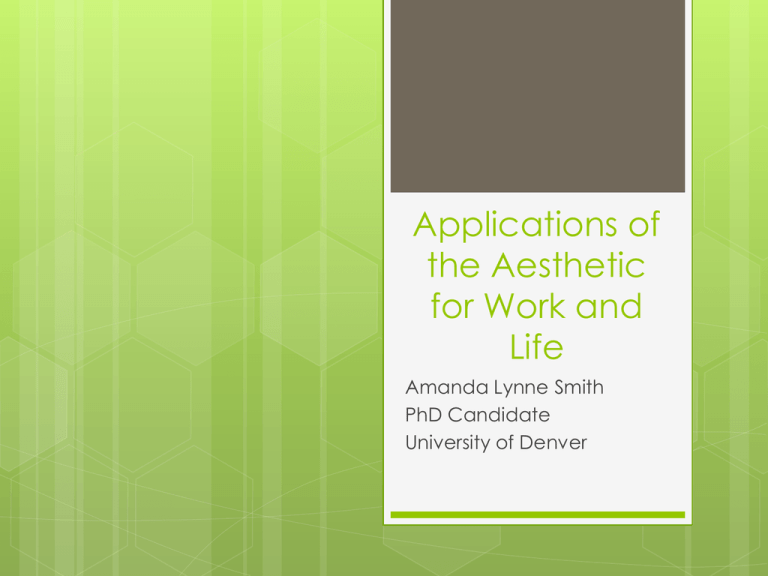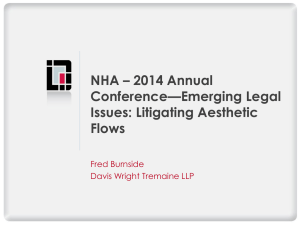Applications of Aesthetic Themes for Higher Education
advertisement

Applications of the Aesthetic for Work and Life Amanda Lynne Smith PhD Candidate University of Denver Defining the Aesthetic The word “aesthetic” comes from the Greek word, aesthesis, and means recognition via one’s senses. When was the last time you had an aesthetic experience? Watching a breathtaking sunset Listening to music or watching a play Having a meaningful conversation Examining a piece of art Creating something Sitting still and feeling the sun warm your skin Participating in a physical activity Engage your Senses… https://www.youtube.com/watch?v=m_5g_ D_iP2s Reflection Take a moment to consider the way that this experience made you feel. The music, the images – did it make you feel calm, present? Did it take you back, remind you of something or make you day dream about places you want to go? What stands out and why? Introduction and Background Captivating College Classrooms Applications of Aesthetic Themes for Higher Education The Aesthetic Themes Connections Risk-taking Imagination Sensory Experience Perceptivity Active Engagement Research Questions 1. 2. 3. What are the intentions of aesthetically minded teachers who purposefully utilize the Six Dimensions of Teaching and Learning (CRISPA) in higher education institutions? How do aesthetic themes (CRISPA) operationalize in the classrooms of higher education? What is the significance of studying the practices of aesthetically minded teachers for higher education and education in general? Methodology Educational Connoisseurship and Criticism Educational connoisseurship and criticism is an arts-based qualitative method of inquiry initiated by Elliot Eisner (1998, 2002b) Overview of the Literature Alexander Baumgarten Immanuel Kant John Dewey Suzanne Langer Alian Badiou Mihaly Csikszentmihalyi Elliot Eisner Maxine Greene Bruce Uhrmacher Alexander Baumgarten and Immanuel Kant “There are two sources of human knowledge, which perhaps spring from a common but to us unknown root, namely, sensibility and understanding.” “The distinctive activity of the mind is to synthesize and unify experience and to do so, sensation, imagination, and memory must be involved.” John Dewey “Through the creation of the expressive object, the artist and the observer encounter each other and the origin of the experience.” “Such a lived moment is completely memorable and connected by distinct, and unique qualities that bind the experience into one that makes them felt as an interlaced and profound whole.” Suzanne Langer and Alain Badiou “The visual elements of experience are abstracted by cancelling out others.” Badiou referred to these phenomena in his description of the poem and how poet and thinker rely on one another and “embody within the work the opening out of its closure.” Mihaly Cskikzentmihalyi The overarching satisfaction that is felt through interaction with aesthetic pleasure is generated from one’s experience of aligning intuition and understanding. Concepts of “Flow” Elliot Eisner and Maxine Greene “Aesthetic modes of knowing” “Aesthetics as a particular field in philosophy - one concerned about perception, sensation, imagination, and how they relate to knowing, understanding, and feeling about the world.” Bruce Uhrmacher Investigated the possibility of facilitating “flow” and other outcomes of aesthetic experience, while isolating a concise number of aesthetic themes that teachers could use in their classrooms in order to facilitate enhanced learning opportunities for students. Theory into Practice Indicators the Aesthetic Themes are Present Well conceived lessons Integration of various disciplines Enhanced creativity Connection making through the non-linear Shared learning Negotiation skills Increased communication Caring environment Implications of the Research Increased college student engagement Higher graduation rates New approaches to teaching and learning A more holistic educational experience Individuals who are creative problem solvers New strategies and best practices for online education Applications for Work and Life Work and Professional Growth Hobbies and Recreation Love and Relationships Personal and Spiritual Growth Work and Professional Growth Determination, Integrity and Purpose Hobbies and Recreation Passion, Persistence and Courage Love and Relationships Vulnerability, Trust and Tenderness Personal and Spiritual Growth Transcendence, Gratitude and Hope References Badiou, A. (2004). Handbook of inaesthetics (A. Toscano, Trans.). Palo Alto, CA: Stanford University Press. Csikszentmihalyi, M., & Robinson, R. (1990). The art of seeing: An interpretation of the aesthetic encounter. Malibu, CA: John Paul Getty Trust. Dewey, J. (1934). Art as experience. New York: Perigee Books. Eisner, E. (1998). The enlightened eye: Qualitative inquiry and the enhancement of educational practice. New Jersey: Merrill Prentice Hall. Moroye, C. M. & Uhrmacher, P. B. (2009). Aesthetic themes of education and the art of teaching. Curriculum and Teaching Dialogue. Charlotte Information Age. “A happy life is one in accordance with its own nature.” -Lucius Annaeus Seneca Indicators of Life Balance Work-Life balance Fulfillment - and personal or emotional fulfillment Well-being, and personal wellbeing/wellbeing Happiness, or simply being happy At peace (with myself or life) or in harmony with life Contentment, and inner calm











